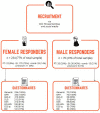Body Figure Idealization and Body Appearance Pressure in Fitness Instructors
- PMID: 33424701
- PMCID: PMC7793892
- DOI: 10.3389/fpsyg.2020.585901
Body Figure Idealization and Body Appearance Pressure in Fitness Instructors
Abstract
Purpose: The fitness centers are settings for health promotion, yet may serve as a stage for counterproductive figure idealization. Such idealization may take the form of a drive toward the thin, the muscular, or lean body figure ideal, which all hold the potential to impel an experience of body appearance pressure (BAP) and body dissatisfaction. The aim of this study was to explore figure idealization, body dissatisfaction, and experience of BAP in fitness instructors.
Materials and methods: Fitness instructors, 70 (23%) males and 236 (77%) females, were recruited through their facility chief executive officer and social media for a digital survey on mental health. Results are presented for body appreciation (BAS-2), body dissatisfaction (EDI-BD), drive for muscularity (DM), drive for leanness (DLS), questions on BAP, symptoms of eating disorders (EDE-q), and history of weight regulation and eating disorders (EDs).
Results: Attempts to gain body weight were reported by 17% of females and 53% of males, whereas ∼76% of males and females, respectively, reported to have attempted weight reduction. Reasons for body weight manipulation were predominantly appearance related, and 10-20% reported disordered eating behavior. Mean BAS-2 and EDI-BD were acceptable, but 28% of females were above clinical cutoff in EDI-BD, and mean DLS were high in both sexes. In total, 8% of females were above clinical cutoff in EDE-q, which corresponded well with the self-reported ED. Approximately 90% of the sample perceived BAP to be a societal issue and reported predominantly customers and colleagues to be the cause of their personal experience of BAP. Fewer than 50% knew of any actions taken by their employer to reduce BAP. There were few differences according to profession or educational level.
Conclusion: Fitness instructors report BAP to affect them negatively, which may put them at risk of impaired mental health. Educational level did not protect against figure idealization and BAP. To care for their employees and to optimize their position as a public health promoter, the fitness industry should target BAP in health promotion programs.
Keywords: body figure idealization; body image; drive for leanness; drive for muscularity; eating disorders; group instructors; personal trainers.
Copyright © 2020 Mathisen, Aambø, Bratland-Sanda, Sundgot-Borgen, Svantorp-Tveiten and Sundgot-Borgen.
Conflict of interest statement
The authors declare that the research was conducted in the absence of any commercial or financial relationships that could be construed as a potential conflict of interest.
Figures


Similar articles
-
Disordered eating behavior among group fitness instructors: a health-threatening secret?J Eat Disord. 2015 Jun 24;3:22. doi: 10.1186/s40337-015-0059-x. eCollection 2015. J Eat Disord. 2015. PMID: 26106479 Free PMC article.
-
Compulsive exercise and mental health challenges in fitness instructors; presence and interactions.J Eat Disord. 2021 Sep 2;9(1):107. doi: 10.1186/s40337-021-00446-0. J Eat Disord. 2021. PMID: 34493315 Free PMC article.
-
Mental Health Symptoms Related to Body Shape Idealization in Female Fitness Physique Athletes.Sports (Basel). 2019 Nov 14;7(11):236. doi: 10.3390/sports7110236. Sports (Basel). 2019. PMID: 31739479 Free PMC article.
-
New Body Scales Reveal Body Dissatisfaction, Thin-Ideal, and Muscularity-Ideal in Males.Am J Mens Health. 2018 Jul;12(4):740-750. doi: 10.1177/1557988318763516. Epub 2018 Mar 20. Am J Mens Health. 2018. PMID: 29557236 Free PMC article.
-
Eating-disorder psychopathology in female athletes and non-athletes: A meta-analysis.Int J Eat Disord. 2022 Jul;55(7):861-885. doi: 10.1002/eat.23748. Epub 2022 Jun 4. Int J Eat Disord. 2022. PMID: 35665528 Free PMC article. Review.
Cited by
-
Quality of life of fitness professionals in Portugal: Comparative and correlation study.Front Psychol. 2022 Aug 24;13:958063. doi: 10.3389/fpsyg.2022.958063. eCollection 2022. Front Psychol. 2022. PMID: 36092028 Free PMC article.
-
The Risk of Disordered Eating in Fitness Club Members-A Cross-Sectional Study.Sports (Basel). 2024 Dec 12;12(12):343. doi: 10.3390/sports12120343. Sports (Basel). 2024. PMID: 39728883 Free PMC article.
-
Sexual Harassment in Fitness Instructors: Prevalence, Perpetrators, and Mental Health Correlates.Front Psychiatry. 2021 Oct 29;12:735015. doi: 10.3389/fpsyt.2021.735015. eCollection 2021. Front Psychiatry. 2021. PMID: 34777046 Free PMC article.
-
Body appreciation and body appearance pressure in Norwegian university students comparing exercise science students and other students.BMC Public Health. 2021 Mar 19;21(1):532. doi: 10.1186/s12889-021-10550-0. BMC Public Health. 2021. PMID: 33740918 Free PMC article.
-
Empowered, Yet Vulnerable: Motives for Sport Participation, Health Correlates, and Experience of Sexual Harassment in Female Combat-Sport Athletes.Sports (Basel). 2022 Apr 29;10(5):68. doi: 10.3390/sports10050068. Sports (Basel). 2022. PMID: 35622477 Free PMC article.
References
-
- Bakken A., Sletten M., Eriksen I. (2019). Generation performance? Tidsskrift Ungdomsforskning 18:30.
LinkOut - more resources
Full Text Sources

